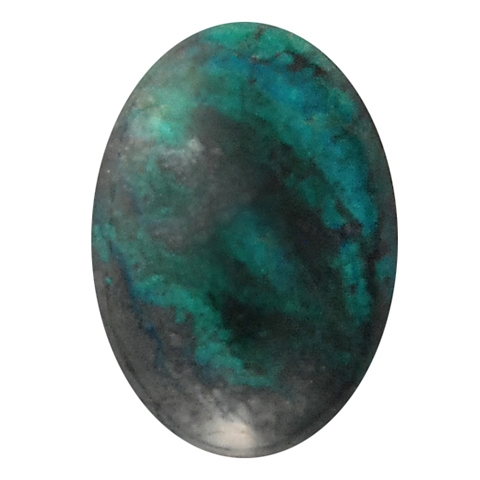Chrysocolla
Found in oxidized zones of copper deposits. A hydrous copper silicate, chrysocolla is a minor copper ore. It is found in copper mines in arid areas, such as the American Southwest. Chrysocolla occurs in copper veins and is formed by silica containing waters. It is often mixed with copper compounds, and associated minerals including quartz, azurite, turquoise, limonite, cuprite, tenorite, hematite and malachite.
Chemical composition (Cu,Al)2H2Si2O5(OH)4·nH2O
Color Sky blue, greenish blue or green, often streaked with black
Lustre Vitreous, dull, or earthy
Hardness 2.0 – 4.0
Crystal system Monoclinic
Origin USA, Mexico, England, Chile, Israel, Germany, UK, Katanga (Congo)
Healing properties*
Chrysocolla holds feminine energy. It symbolizes beauty, love and harmony. A force resides in its softness. It harmonizes groups and environments. Good for throat and chest problems. Relaxes the body and emotions. Enhances the flow of creativity.
Chrysocolla holds feminine energy. It symbolizes beauty, love and harmony. A force resides in its softness. It harmonizes groups and environments. Good for throat and chest problems. Relaxes the body and emotions. Enhances the flow of creativity.
Folklore
The name first appears in 315 B.C., in the writings of Theophrastus, and comes from the Greek ‘chrysos’, for gold, and ‘kolla’, for glue, due to the fact that chrysocolla resembles other materials, including borax, which were used as a flux in soldering gold in ancient times. In the 1950s, U.S. lapidaries voted chrysocolla-colored chalcedony the “most popular American gem”.
The name first appears in 315 B.C., in the writings of Theophrastus, and comes from the Greek ‘chrysos’, for gold, and ‘kolla’, for glue, due to the fact that chrysocolla resembles other materials, including borax, which were used as a flux in soldering gold in ancient times. In the 1950s, U.S. lapidaries voted chrysocolla-colored chalcedony the “most popular American gem”.






